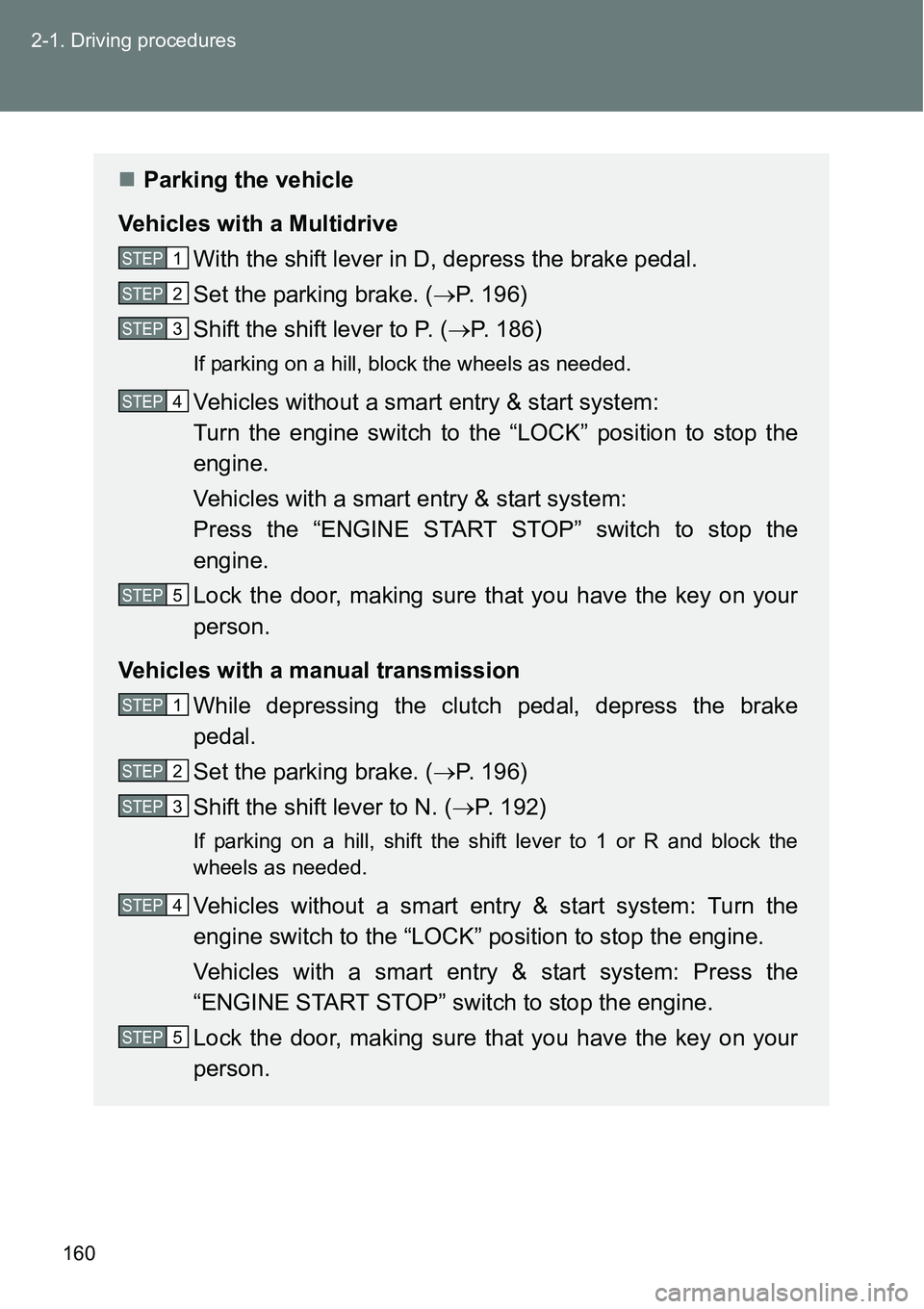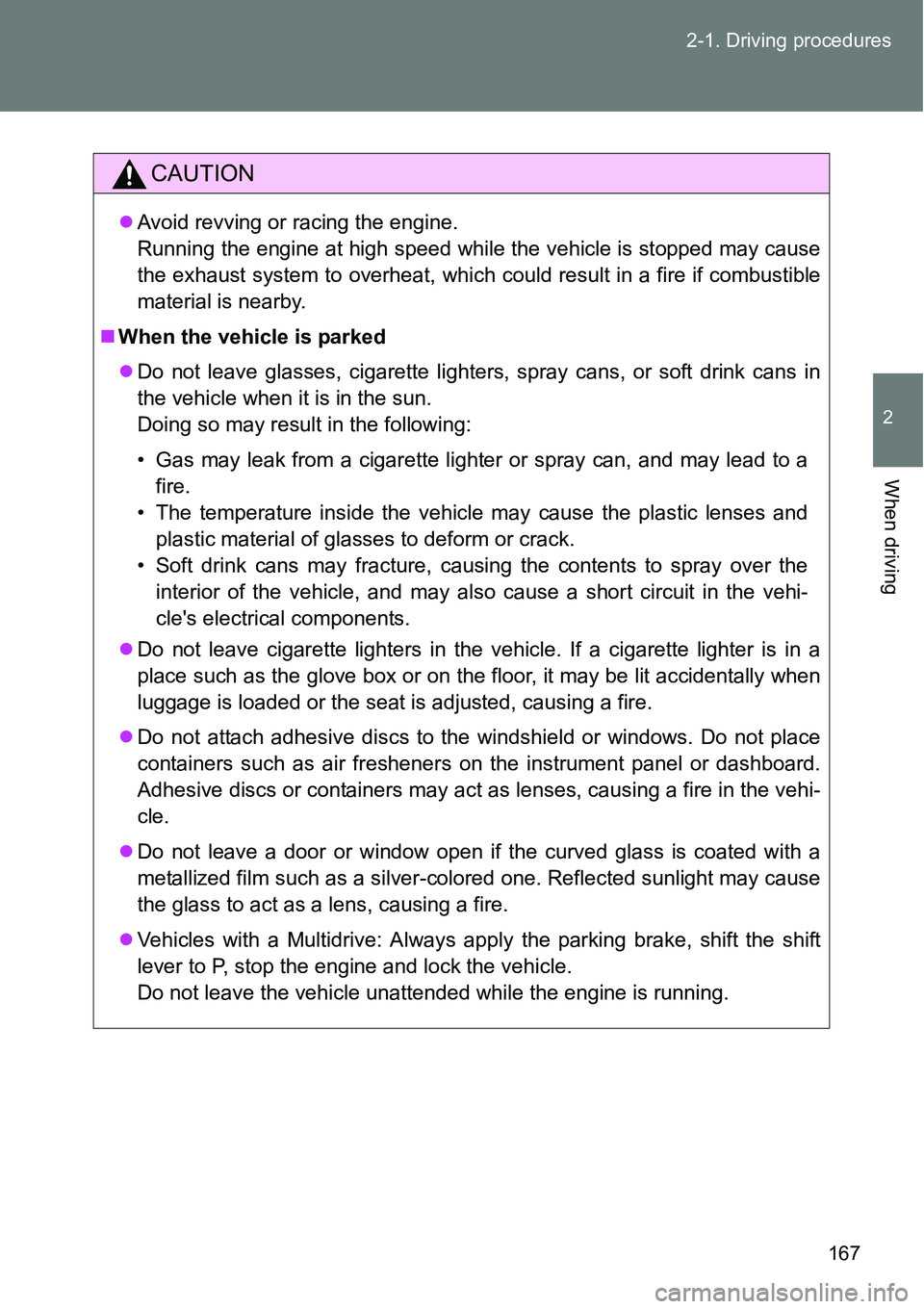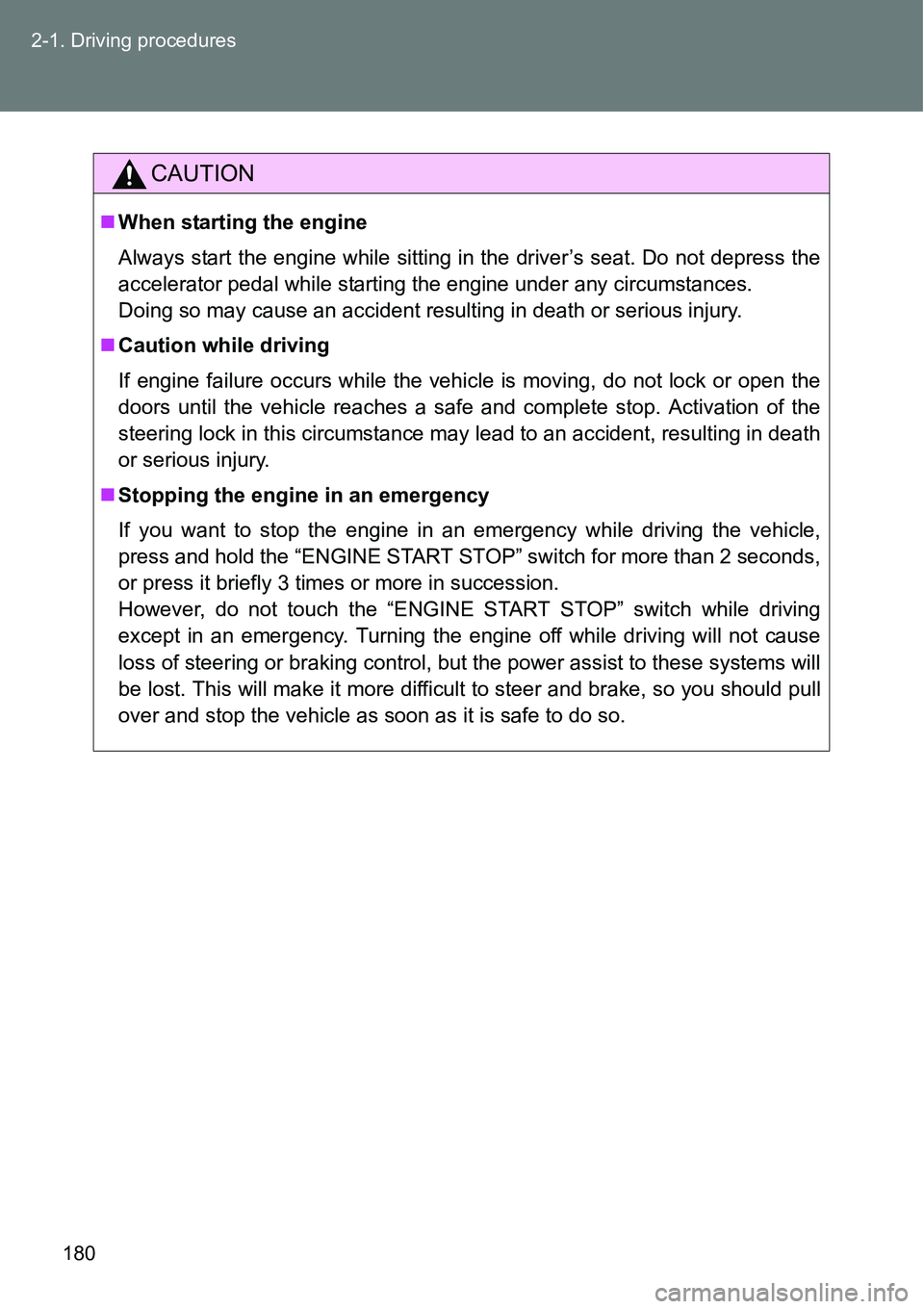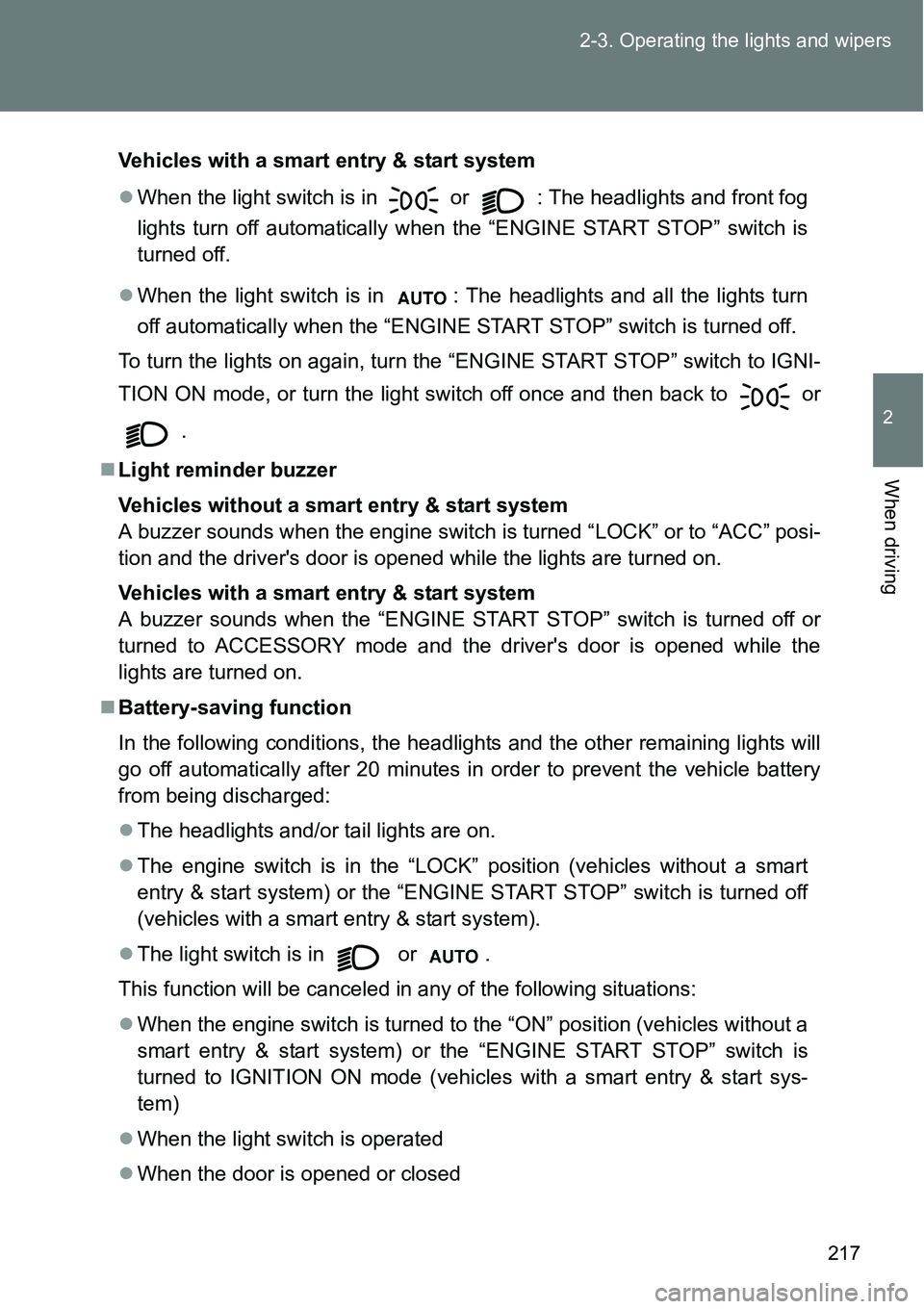Page 118 of 564
118 1-6. Theft deterrent system
System maintenance
The vehicle has a maintenance-free type alarm system.
Items to check before locking the vehicle
To prevent unexpected triggering of the alarm and vehicle theft, make sure
of the following.
Nobody is in the vehicle.
The windows are closed before the alarm is set.
No valuables or other personal items are left in the vehicle.
Triggering of the alarm
The alarm may be triggered in the following situations.
(Stopping the alarm deactivates the alarm system.)
Vehicles without a smart entry & start
system: The doors are unlocked using
the key.
Vehicles with a smart entry & start sys-
tem: The doors are unlocked using the
mechanical key.
A person inside the vehicle opens a
door or the hood.
The battery is recharged or replaced
when the vehicle is locked.
Page 119 of 564
119 1-6. Theft deterrent system
1
Before driving
Alarm-operated door lock
When the alarm is operating, the doors are locked automatically to pre-
vent intruders.
Do not leave the key inside the vehicle when the alarm is operating, and
make sure the key is not inside the vehicle when recharging or replacing
the battery.
Customization that can be configured at any authorized Toyota dealer
or repairer, or another duly qualified and equipped professional
Settings of the alarm using the key can be changed.
(Customizable features: P. 540)
NOTICE
To ensure the system operates correctly
Do not modify or remove the system. If modified or removed, the proper
operation of the system cannot be guaranteed.
Page 160 of 564

160 2-1. Driving procedures
Parking the vehicle
Vehicles with a Multidrive
With the shift lever in D, depress the brake pedal.
Set the parking brake. (P. 196)
Shift the shift lever to P. (P. 186)
If parking on a hill, block the wheels as needed.
Vehicles without a smart entry & start system:
Turn the engine switch to the “LOCK” position to stop the
engine.
Vehicles with a smart entry & start system:
Press the “ENGINE START STOP” switch to stop the
engine.
Lock the door, making sure that you have the key on your
person.
Vehicles with a manual transmission
While depressing the clutch pedal, depress the brake
pedal.
Set the parking brake. (P. 196)
Shift the shift lever to N. (P. 192)
If parking on a hill, shift the shift lever to 1 or R and block the
wheels as needed.
Vehicles without a smart entry & start system: Turn the
engine switch to the “LOCK” position to stop the engine.
Vehicles with a smart entry & start system: Press the
“ENGINE START STOP” switch to stop the engine.
Lock the door, making sure that you have the key on your
person.
STEP1
STEP2
STEP3
STEP4
STEP5
STEP1
STEP2
STEP3
STEP4
STEP5
Page 167 of 564

167 2-1. Driving procedures
2
When driving
CAUTION
Avoid revving or racing the engine.
Running the engine at high speed while the vehicle is stopped may cause
the exhaust system to overheat, which could result in a fire if combustible
material is nearby.
When the vehicle is parked
Do not leave glasses, cigarette lighters, spray cans, or soft drink cans in
the vehicle when it is in the sun.
Doing so may result in the following:
• Gas may leak from a cigarette lighter or spray can, and may lead to a
fire.
• The temperature inside the vehicle may cause the plastic lenses and
plastic material of glasses to deform or crack.
• Soft drink cans may fracture, causing the contents to spray over the
interior of the vehicle, and may also cause a short circuit in the vehi-
cle's electrical components.
Do not leave cigarette lighters in the vehicle. If a cigarette lighter is in a
place such as the glove box or on the floor, it may be lit accidentally when
luggage is loaded or the seat is adjusted, causing a fire.
Do not attach adhesive discs to the windshield or windows. Do not place
containers such as air fresheners on the instrument panel or dashboard.
Adhesive discs or containers may act as lenses, causing a fire in the vehi-
cle.
Do not leave a door or window open if the curved glass is coated with a
metallized film such as a silver-colored one. Reflected sunlight may cause
the glass to act as a lens, causing a fire.
Vehicles with a Multidrive: Always apply the parking brake, shift the shift
lever to P, stop the engine and lock the vehicle.
Do not leave the vehicle unattended while the engine is running.
Page 178 of 564

178 2-1. Driving procedures
Operation of the “ENGINE START STOP” switch
When operating the “ENGINE START STOP” switch, one short, firm press is
enough. If the switch is pressed improperly, the engine may not start or the
“ENGINE START STOP” switch mode may not change. It is not necessary to
press and hold the switch.
Electronic key battery depletion
P. 4 4
Conditions affecting operation
P. 4 1
Notes for the entry function
P. 4 2
If the engine does not start
The engine immobilizer system may not have been deactivated.
(P. 105)
Steering lock
After turning the “ENGINE START STOP” switch off and opening and closing
the doors, the steering wheel will be locked due to the steering lock function.
Operating the “ENGINE START STOP” switch again automatically cancels
the steering lock.
Vehicles with a Multidrive: Check
that the shift lever is securely set in
P. The engine may not start if the
shift lever is displaced out of P. The
smart entry & start system indicator
light (green) will flash quickly.
Page 180 of 564

180 2-1. Driving procedures
CAUTION
When starting the engine
Always start the engine while sitting in the driver’s seat. Do not depress the
accelerator pedal while starting the engine under any circumstances.
Doing so may cause an accident resulting in death or serious injury.
Caution while driving
If engine failure occurs while the vehicle is moving, do not lock or open the
doors until the vehicle reaches a safe and complete stop. Activation of the
steering lock in this circumstance may lead to an accident, resulting in death
or serious injury.
Stopping the engine in an emergency
If you want to stop the engine in an emergency while driving the vehicle,
press and hold the “ENGINE START STOP” switch for more than 2 seconds,
or press it briefly 3 times or more in succession.
However, do not touch the “ENGINE START STOP” switch while driving
except in an emergency. Turning the engine off while driving will not cause
loss of steering or braking control, but the power assist to these systems will
be lost. This will make it more difficult to steer and brake, so you should pull
over and stop the vehicle as soon as it is safe to do so.
Page 184 of 564
184 2-1. Driving procedures
Turning the key from “ACC” to “LOCK”
Vehicles with a Multidrive: Shift the shift lever to P. (P. 186)
Vehicles with a manual transmission: Shift the shift lever to N.
(P. 192)
If the engine does not start
The engine immobilizer system may not have been deactivated. (P. 105)
When the steering lock cannot be released
Key reminder function
A buzzer sounds if the driver’s door is opened while the engine switch is in
the “LOCK” or “ACC” position to remind you to remove the key.
STEP1
Push in the key and turn it to the “LOCK”
position.STEP2
When starting the engine, the engine
switch may seem stuck in the “LOCK”
position. To free it, turn the key while turn-
ing the steering wheel slightly left and
right.
Page 217 of 564

217 2-3. Operating the lights and wipers
2
When driving
Vehicles with a smart entry & start system
When the light switch is in
or : The headlights and front fog
lights turn off automatically when the “ENGINE START STOP” switch is
turned off.
When the light switch is in : The headlights and all the lights turn
off automatically when the “ENGINE START STOP” switch is turned off.
To turn the lights on again, turn the “ENGINE START STOP” switch to IGNI-
TION ON mode, or turn the light switch off once and then back to
or
.
Light reminder buzzer
Vehicles without a smart entry & start system
A buzzer sounds when the engine switch is turned “LOCK” or to “ACC” posi-
tion and the driver's door is opened while the lights are turned on.
Vehicles with a smart entry & start system
A buzzer sounds when the “ENGINE START STOP” switch is turned off or
turned to ACCESSORY mode and the driver's door is opened while the
lights are turned on.
Battery-saving function
In the following conditions, the headlights and the other remaining lights will
go off automatically after 20 minutes in order to prevent the vehicle battery
from being discharged:
The headlights and/or tail lights are on.
The engine switch is in the “LOCK” position (vehicles without a smart
entry & start system) or the “ENGINE START STOP” switch is turned off
(vehicles with a smart entry & start system).
The light switch is in or .
This function will be canceled in any of the following situations:
When the engine switch is turned to the “ON” position (vehicles without a
smart entry & start system) or the “ENGINE START STOP” switch is
turned to IGNITION ON mode (vehicles with a smart entry & start sys-
tem)
When the light switch is operated
When the door is opened or closed